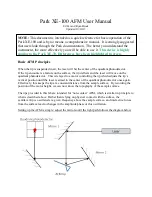
2: To get started
The objectives have already been placed in the nose piece in the right sequence.
They are parfocal and parcentered. Unless necessary, do not remove the objectives.
Put the plug into an earthed power point (see if the right voltage is provided). Switch
on the lamp. To guide the light through the slide and the optical system in the most
efficient way, the iris diaphragm and condenser (**) should be adjusted as follows:
open the iris diaphragm (15) totally
rotate the nose piece (7) to place objective 4x in line with the slide
unscrewing the fixation screw (3)
remove the eyepiece (1) from the tube (2)
close the iris diaphragm until 70-80% of the light is still allowed to pass
place the eyepiece back in the tube
The clarity of the image depends upon the size of the aperture. As the aperture
becomes smaller, the contrast and depth of focus increases, but the resolving power
decreases. The right combination of these factors resolve into the clearest image.
In case of an adjustable Abbe condenser N.A. 1,25 please take notice of following.
When using an objective with a higher numerical aperture (N.A.) proper focussing of
the Abbe condenser is important. Adjust the Abbe condenser by turning it up or
down. Make sure that the field of view is evenly illuminated.
Place the slide on the stage (19), lift up the stage clips (20), and secure the slide.
Make sure the objective with the smallest magnification (4x) is above the slide.
Use coarse adjustment (9) to focus the specimen. After this, the fine adjustment (11)
is used to refine the image. By revolving the nose piece, and bring another objective
in the path of light, a different total magnification will be reached. If magnification is
increased step by step (revolving nose piece to objective with higher magnification),
usually focussing can be done just using fine focussing adjustment (11).
(**) only applicable in models with adjustable condenser
3: Safety notes
Only use earthed power points.
Before maintaining, opening or cleaning the microscope make sure the mains
plug is disconnected from the power point.
Clean the optical parts only with a soft cloth. Do not touch the lenses with your
fingers. Do not soak the lenses in cleaning liquids.
Do not allow any contact between liquids and electrical parts.
4: Replacing bulb
( Not applicable for the LED-CIS microscopes )
Read point 3, Safety notes, carefully
Wait until the temperature of the microscope and electrical parts are cool
Never touch the bulb with naked fingers
Be sure of using the same type of spare bulb as used in the microscope
By the microscope with the tungsten lamp ( 76002, 76010, 76015 & 76021 ) the light
bulb can be changed by unscrewing the lamp house ( Be sure it is cooled down ).
To prevent condensation of the optical parts,
it is recommendable to let the microscope get adapted to the room temperature
while still in the original packing























